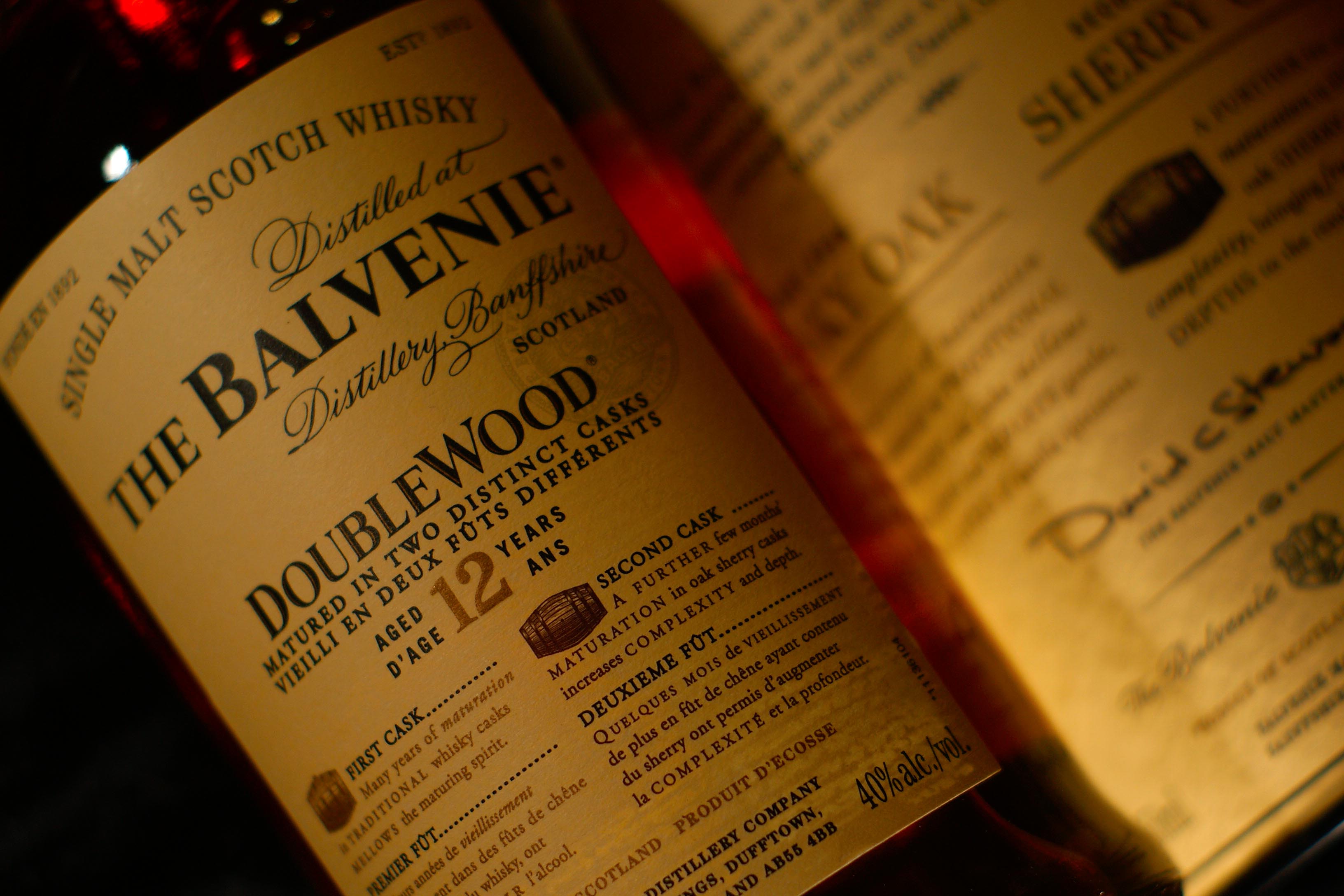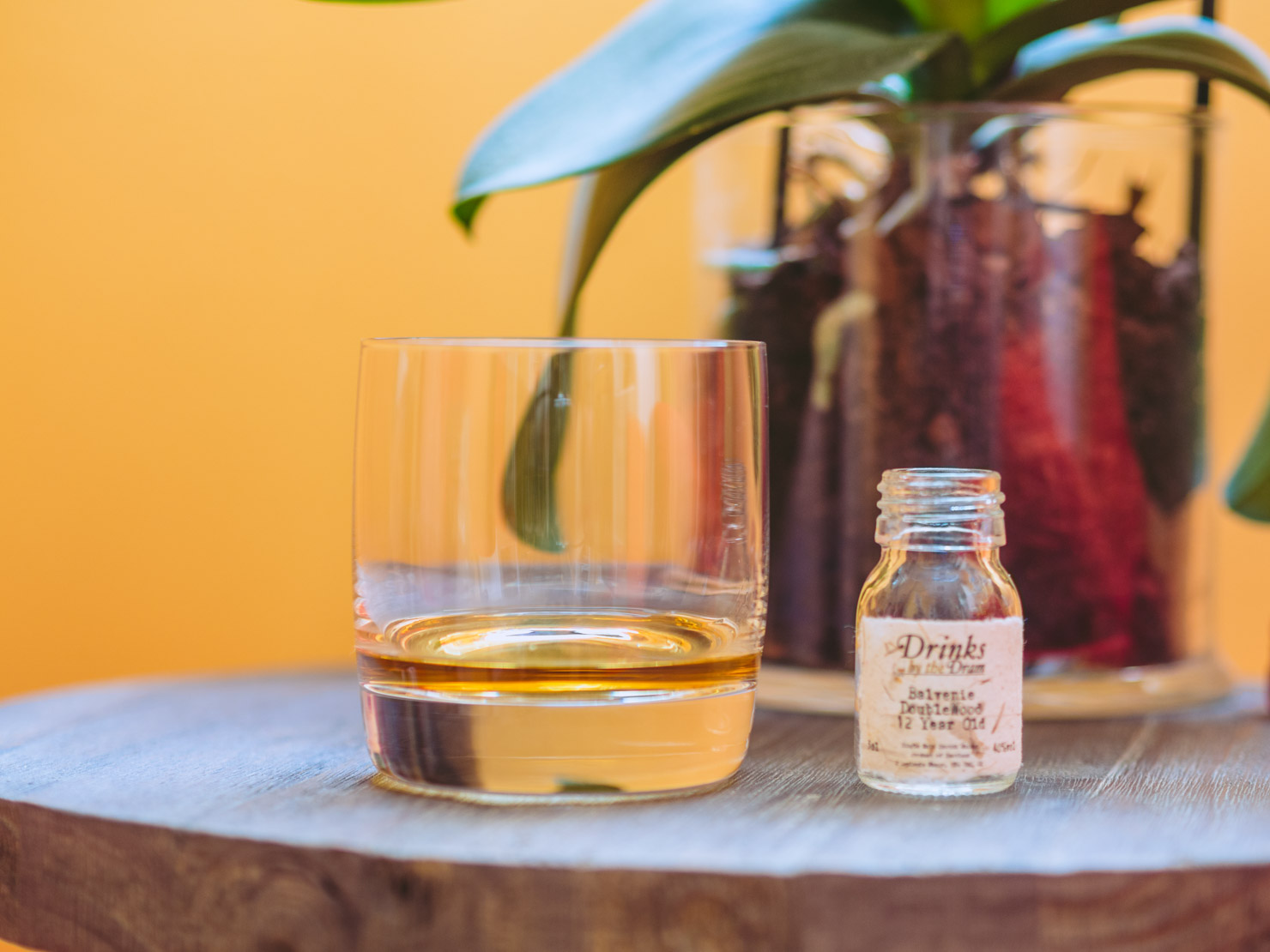It’s funny how some of the best things in life happen entirely by chance.
On paper, I shouldn’t be writing this article right now. This single malt didn’t make my initial list of candidates, mostly because I didn’t even know of its existence when I placed my original 11-dram order with Master of Malt. I only learned of it later that day, when I asked Matt Gemmell on Twitter to recommend a nice young single malt for, ahem, research purposes.
The following morning though, I received a very polite phone call from Master of Malt. As luck would have it, there had been a problem with my order — the PayPal payment didn’t go through — and so I was able to add Matt’s recommendations to the list at the very last minute. Those recommendations were the Glenmorangie Quinta Ruban 12 Year Old, which I reviewed here a few weeks ago, and of course The Balvenie DoubleWood Aged 12 Years, which we have here today.
The Balvenie DoubleWood Aged 12 Years comes in a fancy box. Photo Credit: Michael Bentley.
If you recall, I wasn’t overly enthusiastic about the Quinta Ruban. Don’t get me wrong, it’s clearly a very fine whisky, just not to my particular taste. This Balvenie, on the other hand, has won me over completely, and I’d go as far as to say it has become my new social drink of choice.
The Balvenie distillery
In another happy coincidence, today I received my much-awaited copy of Mark Bylok’s excellent book, The Whisky Cabinet. I had been hoping to lay my dirty hands on this book since before I even started this article series, back in October. It’s been a while but I’m happy to say, it’s been well worth the wait.
The Whisky Cabinet, by Mark Bylok. A perfect coffee-table book if I ever saw one.
I haven’t had enough time to dive deep into it, but I’m really loving what I’ve seen so far. Great photography, an amazing selection of whiskies from all over the world and the clear, precise writing Mark is so good at. You can expect some more in-depth comments about the book in a few weeks but for now, suffice it to say it’s very, very good.
Thanks to Mark’s book, for example, I found out that the Balvenie distillery, located in the Speyside region, was built by the Grant family — of Glenfiddich fame — and that it started operating just six years after Glenfiddich began producing their world-famous whisky. Their idea was for Balvenie to help meet some of Glenfiddich’s demand, but it quickly found a character of its own.
Unlike Glenfiddich, Balvenie uses primarily American oak casks to age their whiskies, while using European oak casks only for the finishing years. This is true for the majority of their denominations. Balvenie was actually the distillery that pioneered wood finishing, a practice now considered standard and widely used by the rest of the whisky industry.
The Balvenie distillery in Speyside. Photo Credit: Martyn Jenkins.
The DoubleWood Aged 12 Years
As its name implies and like many of Balvenie’s denominations, the DoubleWood 12 is a wood-finished whisky. In this case, the whisky is first aged in ex-bourbon American oak casks for ten years and then finished in ex-sherry European oak casks for another two years, giving it that extra bit of character DoubleWood is known for.
The DoubleWood 12 bottle sports a classically elegant design. Photo Credit: Marc Gélinas.
The DoubleWood 12 has a slightly darker, warmer color than most whiskies its age due to its sherry finish. I’d rate it between a 1.3 (russetmuscat) and a 1.5 (auburn, polished mahogany) on the Whisky Magazine color chart:
Click or tap on the chart to view it full-size.
The DoubleWood Aged 12 Years is the spiritual successor to the Balvenie Classic of the 1980’s. For a little more on the story behind this, let’s take a look at what Balvenie’s Malt Master David Stewart has to say:
The nose
This is clearly the most easygoing whisky I have nosed so far. It’s very pleasant on the nose, with plenty of vanilla and caramel notes. It’s not a terribly complex whisky like the Quinta Ruban, and I mean that in a good way. Instead, this one gives you everything right away, but in a subtle, almost delicate way. A very balanced aroma that you’ll never find dull, that’s for sure.
The palate
This is where the DoubleWood shines. It’s just the right amount of spice and the right amount of toffee, both playing together in perfect harmony. I also detect some very faint hints of fruit, perhaps red berries or something along those lines. It has a very elegant sweetness that is not too bold, and adds to the overall experience. All in all, there’s really nothing bad to say about it, except it’s extremely difficult to stop after only one drink. Be advised.
The DoubleWood is bottled at 40% alcohol, so burn is naturally kept to a minimum due to its moderate strength. Add water at your discretion, but be careful not to drown it. I’ve found that just a splash of water works best, but I won’t go out of my way to get it. And of course, don’t ever use tap water. If you can get some mineral water great but if not, just drink it neat. Have smaller sips and your saliva will naturally dilute the drink. That’s another excellent tip I learned from The Whisky Cabinet and in this case, it works like a charm.
The finish
I’d rate it as medium. It lingers on just long enough to make you want more. It’s a diabolically well-engineered drink, at that. The aftertaste is mellow and pleasant, with plenty of caramel notes and perhaps some vanilla undertones lingering as an afterthought.
Perfect for
Like I said in the introduction, the Balvenie DoubleWood Aged 12 Years has become my new favorite single malt, and also my new social drink of choice. It’s one of the few quality single malts that are easy to find in most bars around these peat-forsaken parts, and it deftly hits that elusive sweetspot of being a perfectly enjoyable drink without being overly expensive. I’ve spent the better part of last month and even much of the holidays getting well acquainted with this one, and I just can’t get enough of it.
Therefore, I’d recommend it for any social situation in which you feel like kicking back and relaxing in good company. Leave the deep conversations and worrying thoughts for another day, this is no moment for trouble. And if you’re anything like me, you may end up asking the barkeep to just leave the bottle.
Final words
There’s not much more to say about this single malt, except I really, really like it. As usual, Matt Gemmell was right, and all I have for him is gratitude for encouraging me to discover such an excellent whisky. In the immortal words of Lt. Archie Hicox:
“I must say, damn good stuff, Sir.”











